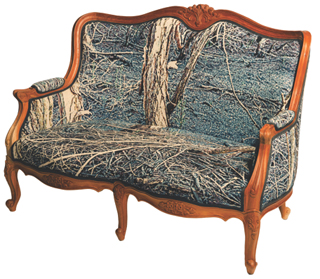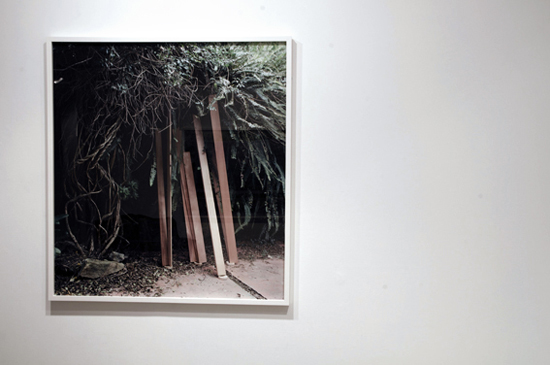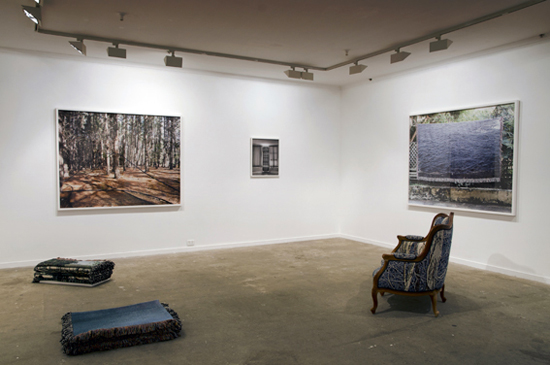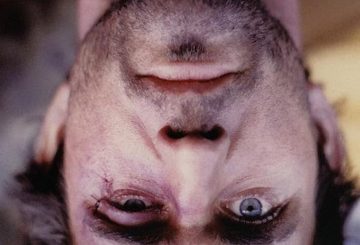Isobel Philip considers the in between spaces of Deb Mansfield‘s installations...
In The Armchair Traveller, her recent show at MOP Projects, Deb Mansfield charmed the viewer with a visual pun. Smack bang in the centre of the gallery was a two-seater Louis XV armchair in disguise. The ornately patterned brocade upholstery was gone and in its place was a tangle of dry undergrowth, an image of the bush floor woven into a photo-tapestry. The chair was a long way from home, the mess of trunks and twigs a far cry from the manicured gardens of Versailles. The fabric transported the chair to an imagined topography – a distant foreign land of uncultivated wildness. It is the virtual travelogue of an inanimate journeyman and that gave new (and emphatically literal) meaning to the term ‘armchair traveller’.
Deb Mansfield, The Armchair Traveller (two-seater), 2013. Photographic-tapestry upholstered into a reproduction Louis two-seater frame, approx 150 x 170 cm
But there was more to the work than elegantly executed witticism. With the photographs and stacked piles photo-tapestries that accompanied the chair, Mansfield unravelled a complex and beautifully refined engagement with the delicate spatial category of the liminal and in-between.
Produced in response to two residencies, one in Launceston, Tasmania and the other in McIvers, Newfoundland in Canada, the work exposed a preoccupation with concepts of the peripheral and the fringe. In both residencies, Mansfield travelled to satellite communities in littoral zones where the land meets the water. These secluded environments have secured permanent tenancy in Mansfield’s work. She awards the littoral – that inconspicuous and indeterminate space that surrounds a landmass – a profound metaphoric potency, the thematic lynchpin of the entire exhibition.
Deb Mansfield, The potential of planks on castors resting between two houses, 2013, Giclee print, 140 x 130 cm.
There were two types of littoral zones: the remote shores of Tasmania and Newfoundland – sites of travel and expedition – and their domestic counterpart, the backyard. Like the boundary between landmass and sea, the backyard is an in-between space. It is a threshold – an interstice – where the limits between inside and outside, private and public, and us and them, collapse.
While the landscape images woven into photo-tapestries were taken in Tasmania, the photographs (or ‘photo-constructs’ in Mansfield’s words) hanging on the walls were all shot in Sydney backyards. These photo-constructs document Mansfield’s quiet interventions in the domestic environment. Rearranging her subjects, she stages her own makeshift tableaux vivants. Her characters are inanimate objects that – like the roving armchair – acquire a performative agency. There is the cluster of wooden planks gathered together under a dense canopy, the rubber pipes that wind their way around tree trunks and the cushion-less chaise longue trying desperately to get out a window. There is also a photo-tapestry (one of those folded in a pile on the gallery floor) hanging across a washing line as if to hide something from view.
Installation shot, The Armchair Traveller, MOP Projects 2013.
These inanimate objects cling to spatial boundaries and perimeters; back fences, windows, and property lines. Like the armchair with its playful study of pastiche exoticism, they too feel the pull of the foreign and the unfamiliar. They all seem to be looking outwards, straining to see what lies beyond the border and across the threshold. The planks of wood lean towards the neighbour’s house, the chaise longue has its face against the window, and the tapestry is high enough to see over the back fence. Transfixed by the unknown, they inhabit the space between here and there. They straddle the littoral zone.
And yet what of the photo-tapestries stacked on the floor of the gallery? Didn’t they also fetishize the perimeter and the edge (not to mention the fringe, which Mansfield has left untrimmed)? A tapestry is an enclosed space with a fixed border, a floating island framed by its own littoral zone. Piled on the floor in the gallery, Mansfield’s tapestries became allegorical surrogates for Tasmania and Newfoundland. The fact that images of these remote landscapes are literally woven into the tapestry, not simply printed on its surface, only fortified this analogy. The image is the tapestry, the tapestry is the land.
By folding and stacking these tapestries, Mansfield obfuscated our view. We can’t see what is hidden between the folds. The landscapes elude us, revealing themselves in small fragments. We have to imagine the rest. In doing so we are absorbed into the work as the performative counterparts of the inanimate objects in the photographs. We become armchair travellers, thinking beyond the edge and into the unknown.





